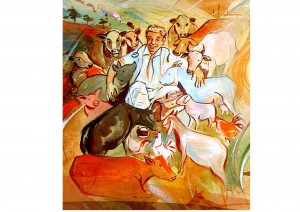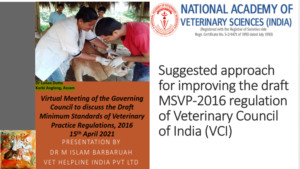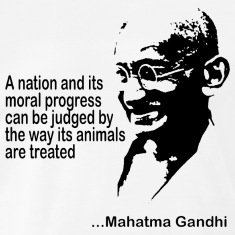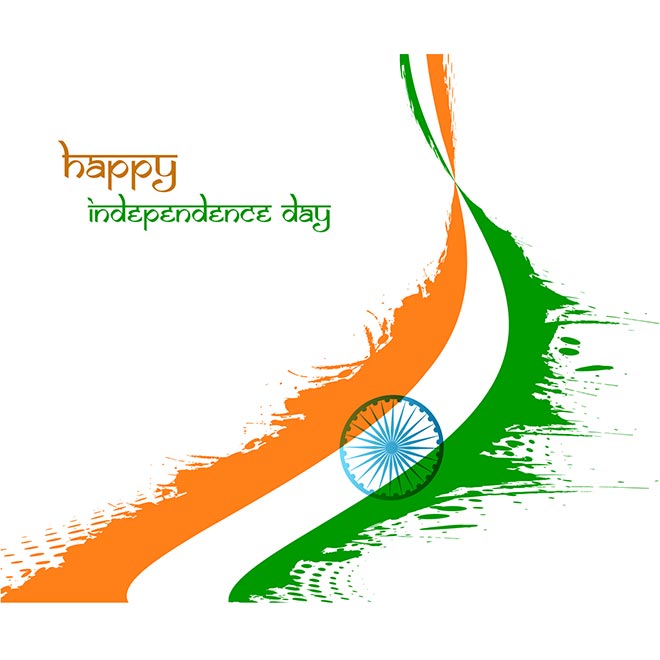 We have prepared the following comments/suggestions on the ‘Draft Minimum Standards of Veterinary Practice Regulations, 2016’ proposed by the Veterinary Council of India. The publication aims at supporting more extensive consultation.
We have prepared the following comments/suggestions on the ‘Draft Minimum Standards of Veterinary Practice Regulations, 2016’ proposed by the Veterinary Council of India. The publication aims at supporting more extensive consultation.
Please help us to improve the communication. You may like to post your views in the comment section.
Dr. Miftahul Islam Barbaruah,
Director, Vet Helpline India Pvt Ltd.
Click Here to download a copy of the proposed regulation.

Click Here to download an invited presentation made before the honorable governing council members of the National Academy of Veterinary Sciences (India)
Click Here to read our earlier publication on ” Organizational Strengthening of Veterinary Council of India and State Veterinary Councils (SVCs ) with particular reference to the recommendation from the OIE-India PVS report (2018 )
Part-I
1.Short title and commencement
- (ii)
(x ) and (y) related to Specialist and Super specialist:
MVSc should not be the only criteria. A Veterinarian may do masters in several related fields and serve the profession. Again years of experience should not be the criteria. The application for registration as a specialist in any identified area ( within the veterinary domain ) should be considered based on a transparent evaluation method, e.g., nature of training, the project implemented, cases attended, etc.
Suggested change:
A registered veterinarian with appropriate training/exposure/ experience within the veterinary domain sufficient to be judged as a specialist in the chosen field by an authorized committee of the council.
(aa)
Supervision
Suggested change:
Supervision means guidance and support to para veterinary personnel by a registered veterinarian to promote accountability and teamwork. The supervision of para veterinary personnel by registered veterinarians can be direct/indirect depending on the ground situation and availability of technology-based solutions for sharing information from the point of care or the farm/residence of the client animal owner.
(ab) / (ac)
Super speciality hospital
Suggestion:
A single super specialty hospital is defined as a hospital that is primarily and exclusively engaged in the care and treatment of animals suffering from any specific category of illness.
A super specialty hospital can also be specific to a particular species or specific for Companion animal/work animal / Exotic animals, farm animals, etc.
(ah) / (ai)
Veterinary Hospital
Suggestion:
Similarly, a veterinary hospital can also be specific to Companion animal/work animal / Exotic animals, farm animals, etc.
(ak)
Polyclinic
Suggestion:
A polyclinic is a facility that provides both general and specialist examinations and treatments for a wide variety of diseases and injuries (including emergency care) to outpatients and is usually independent of a hospital. A polyclinic may also provide an on-job training facility.
(ap)
Veterinary Services
Suggestion:
We need to widen the definition covering food safety etc. Many states in India do not have a proper explanation or mandate of public veterinary services.
VCI should simultaneously work on developing a model guideline for the mandate of state public veterinary service.
The definition also needs to acknowledge that it is not only a registered veterinarian responsible for veterinary services. There are other occupations approved suitably by either VCI or other competent authority.
We need to clarify VCI’s role in the context of aquatic health professionals, honey bee health, etc.
As per the recent Terrestrial Animal Health Code, Veterinary Services are defined as:
“Veterinary service means the governmental and non-governmental organisations that implement animal health and welfare measures and other standards and recommendations in the Terrestrial Code and the OIE Aquatic Animal Health Code in the territory. The Veterinary Services are under the overall control and direction of the Veterinary Authority. Private sector organisations, veterinarians, veterinary paraprofessionals or aquatic animal health professionals are normally accredited or approved by the Veterinary Authority to deliver the delegated functions”
General Note for Part -I:
- We need to refer to the Glossary section of the Terrestrial Animal Health Code for various definitions ( https://www.oie.int/index.php?id=169&L=0&htmfile=glossaire.htm ) Or indicate that when a particular definition is not included, one can use the definition provided in Terrestrial Animal Health Code.
- For definition of technical terms (where necessary), we may refer to MSD manual glossary ( https://www.msdvetmanual.com/resourcespages/glossary ) or other such resources.
- A Superspeciality clinic / veterinary hospital / Veterinary polyclinic can also serve as a referral center for Veterinary Clinic / Dispensaries.
- We can consider the definition of viz. Emergency Veterinary Clinic with or without rescue and rehabilitation facility and Mobile Veterinary Clinic
PART -II Accreditation
Point 1-12, & 14-17
Comment /Suggestion:
We need to ensure that VCI / SVCs are autonomous or independent statutory organizations. They only facilitate the mandate of the State Animal Husbandry and Veterinary Departments. There should not be any scope of accreditation committees getting influenced by the government.
Reforms are needed to ensure more representation of private organizations/individuals within VCI / SVCs
When a private veterinarian applies for the accreditation, he/she should do it directly to VCI or concern SVC, not through any official of the state veterinary services.
The accreditation responsibility on the part of VCI / SVC will demand significant investment and capacity building. The transparency of the system will be another big issue.
We need to ensure that there should not be ‘Redtapism’ in the process of granting accreditation.
We would suggest SVCs onboard any suitable private organization(s) to assist in granting accreditation to any applicant based on a transparent scoring system and verifiable documentation of the process adopted ( Refer Passport Seva Service )
We should make accreditation voluntary and demand-driven. The aim should be to create value for VCI / SVC accreditation in the veterinary services sector. A private clinic would benefit from accreditation only if the same help in market differentiation and thus create demand for services it offers. People should voluntarily pay to the approved service provider / VCI or SVC to get the ‘accreditation’ ( including grade ) and use the same to ensure clients about the quality of services.
VCI should also ensure an incentive system for veterinary practice institutions opting for grading under the accreditation scheme.
VCI should promote minimum accreditation ( or grade ) for all veterinary practice institutions only in a phased manner after the following activities:
A.
Notification making mandatory registration of all veterinary practice institutions with geolocation
VCI can promote a mobile application for this, which any registered veterinarian can use to upload their premises details ( along with geolocation ) and get registration details.
B.
Improving VCI data management system
VCI can issue a directive to SVCs to make all endeavor to keep the following data:
For Veterinarians
- Updated service posting /practice location details of registered veterinarians ( Real-time information )
- Date of birth and date of obtaining the registration
- Gender data of registered Veterinarians.
- Data on the advanced qualification / specialized area of the registered Veterinarians ( Intimation in real-time )
For Veterinary Para vets:
- Permitted category-wise essential registration data, e.g., Name, Qualification, Age, Sex, etc
- Nature of qualification obtained with the name of approved training institutes.
- Name of the organization employing the para vet
- Area ( Administrative division ) where services are being rendered.
- List of NGOs training / deploying Community Animal Health Workers (CAHWs)
C.
The commissioning of a detailed study to understand various service delivery systems ( Public / Private /state-wise ) and a general evaluation of available infrastructure. ( VCI can use geolocation data of veterinary practice infrastructure as indicated above and analyze it for livestock census data)
D.
The support to states to conduct self-evaluation of the performance of veterinary services as per the OIE-PVS tool
E.
The declaration of minimum services that a state should make available and accessible in different contexts
We need to focus more on outcome and impact (minimum service achievement as in E ) while suggesting infrastructure detail for any specific veterinary practice institution category. The need is to appreciate that State or private veterinary service may not need a physical veterinary practice institution ) to achieve the minimum service delivery to farmers/animal owners. The farm animal veterinary services approach should be to reach out and provide services at the doorstep of farmers, essentially focusing on herd health management. In the context of animal welfare, we need more mobile rescue/emergency/animal control infrastructure instead of physical hospitals.
Point 13
It is idealistic to expect a registered veterinarian to lead all primary facilities ( Veterinary dispensaries ). We need to change the service delivery model from the mass-centric approach ( Doctor sitting in the hospital and attending to visitors ) to the client-centric mobile service approach with increased engagement between Government and private / non-government service providers. The goal should be to ensure sufficient mobile service units comprising para veterinarians and lead by a registered veterinarian who can reach out to all villages once a week. Again, mobile government units’ service goal should be village herd health management, not just curative care.
II Accreditation committee etc.
Considering the above suggestion, VCI / SVC’s should invite innovative proposals from private parties regarding the accreditation scheme’s implementation. We need multidisciplinary professionals to manage the system at various levels.
- Norms of Veterinary Practice
Point-3 supervision by a registered veterinarian
Following is a glimpse of the role of a Veterinarian in a suggested supervision system. For more details of the supervision system, VCI can request the Government to get access to confidential document tile “Draft Guidelines for Streamlining of Para-Veterinary Services” prepared and submitted by Brooke Hospital for Animals (India) during September 2019
A Veterinarian plays the role of a supervisor, guide, or mentor. The term ‘Supervision’ essentially covers efforts on the part of the supervisor to build the capacity of the people under his/her supervision. The State Government, by proper notification, should declare supervision as an additional job description of select registered Veterinarians who are directly responsible for the preventive, clinical, and extension services delivery. Such notified veterinarians should also be provided with the required logistic resources to perform his / her supervision function. The requirement of logistic resources may vary from State to State and should be decided by a competent authority based on the local situation’s analysis. The performance of Veterinarians in supervision function, when the same is described in his/her job description, should also be assessed periodically and rewarded.
A supervising Veterinarian should be preferably supported financially by the Government or private service provider to conduct a minimum of 3 periodic contact programs per annum for all supervising registered Para veterinarians. The supervising Veterinarians in a particular district, where appropriate, can partner with any institution and organize the contact programs at the district level for better use of resources. The contact programs should be designed to impart new knowledge and to give exposure to products, best practices, and technologies.
For sustainability of the supervision structure mentioned above, the State Government should earmark funds for incentivizing public Veterinarians to act as supervisors. Similarly, private service providers should also suitably compensate registered Veterinarians for their supervision. The extent of incentives, in this case, should be decided mutually.
The supervising Veterinarian should be made answerable to the SVC/State AHD and the court of law for any act of omission by his/her supervisees. The supervising Veterinarian can refer any complaint of unethical behavior by para veterinarians under his/her supervision to the appropriate disciplinary committee of SVC/State AHDs having a representative of the concerned para veterinary category. The notification of the supervision framework by the SVC/State AHD’s as per the VCI Act and application-based data generated from the point of care will substantially reduce the risk of mentoring Veterinarians. The State should also take the initiative to build the capacity of Veterinarians to do adequate supervision.
To further strengthen the supervision framework, supervising Veterinarians’ opinions can be made mandatory for the disbursement of incentives to supervise Para veterinarians.
- Personnel
Point 4,5,6 regarding Para Veterinary Personnel
VCI can request the Government for access to confidential document tile “Draft Guidelines for Streamlining of Para-Veterinary Services” prepared and submitted by Brooke Hospital for Animals (India) during September 2019
Part-III
Guidelines for the Veterinary Practice Institutions
Section A to M
We understand that these are model guidelines only and are not mandatory. However, a committee of suitable technical experts should review each point. We must appreciate the cost of setting up a private clinic and existing municipal regulations in various places forcing clinics to establish only in commercial areas. We can consider some of these to develop a demand-driven accreditation system.
Our goal should be to assist clinics promoted by registered veterinarians to achieve a set of output and outcomes instead of just focusing on the process adopted / infrastructure used. We can think of suggesting a set of management indicators both for Government and private veterinary institutions.
The section on Medical Record is important. We need to highlight the points related to health events documentation, particularly mandatory writing of prescriptions by registered veterinarians following a code of practice to address the AMR issue.
Section N
Continuing Veterinary Education
Comment:
The fixing of CE credit hours for renewal of registration in common practice across the world and professional associations of practicing veterinarians are already active in organizing regular CE programs supported by private companies. The need for VCI is to facilitate an environment where various accredited CE programs (online/offline) are available in the marketplace for Veterinarians to choose from based on their interests. We should avoid situations like a veterinarian epidemiologist is being forced to attend a CE program on veterinary surgery to maintain the credit hours for renewal of his / her registration.
Click Here for a presentation on the suggestion of Vet Helpline India Pvt Ltd for professional efficiency development of Veterinary personnel in India. It was shared during 2019 with the select policy initiators.
VIII. Guidelines for Animal Disease Diagnostic Laboratories
Comment:
I understand these are guidelines only. The word ‘must’ should not be used in the guideline text. I would prefer VCI/SVCs’s provide an incentive to laboratories to get themselves accredited through the existing system.
In general, VCI / SVCs should assist the state pollution control board / municipal boards to develop appropriate guidelines for Veterinary Practice Institutions.
Part -IV
Guidelines for Veterinary Service
- IX. Evaluation of veterinary service establishments
- Certification procedures, Minor Veterinary Services, and Good Veterinary Practice
Comment:
Legal opinion should be taken if such standard text can be included in a notified regulation.
XIII. Supervision and Direction of Minor Veterinary Services
Comment:
The points included in the section need elaborate discussion from the point of view of practical implementation.
VCI can request the Government to access the confidential document tile “Draft Guidelines for Streamlining of Para-Veterinary Services” prepared and submitted by Brooke Hospital for Animals (India) during September 2019.
A detailed document for harmonization of Minor Veterinary Notifications across the states submitted by the Brooke Hospital for Animals (India) is also available with the Government.
Part -V
Minimum Standards for Veterinary Practice Institution
XV(5)
Regarding the number of outpatient cases to be attended by a single registered Veterinary practitioner in 8 working hours should not exceed 50
Comment:
As indicated earlier, there is a need to change the approach from a traditional mass-centric curative approach to a herd health client-centric ( at the doorstep of the farmer ) approach.
XVI.
It is good to specify minimum standards for physical veterinary practice institutions. However, we need more investment in facilities/infrastructure/workforce / I T application, which permits service delivery at the farmers’ doorstep.
The regulation document should specify models that can be adopted to ensure 5 A’s of service delivery: availability, acceptability, access, adequacy, affordability,
Note on resource mobilization:
A resource mobilization plan that considers the scope of public-private partnerships will be crucial to ensure the regulations are implemented in true spirits.
A political will and a strong collaboration of VCI with the government and other knowledge and skill-based institutions will be a prerequisite to achieving the goal.




